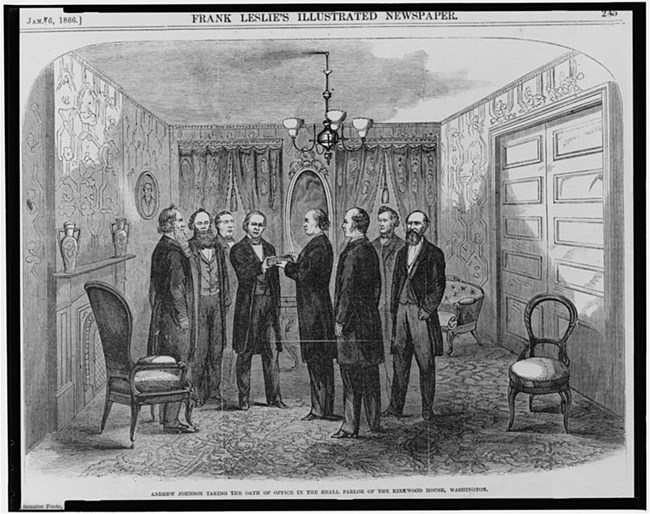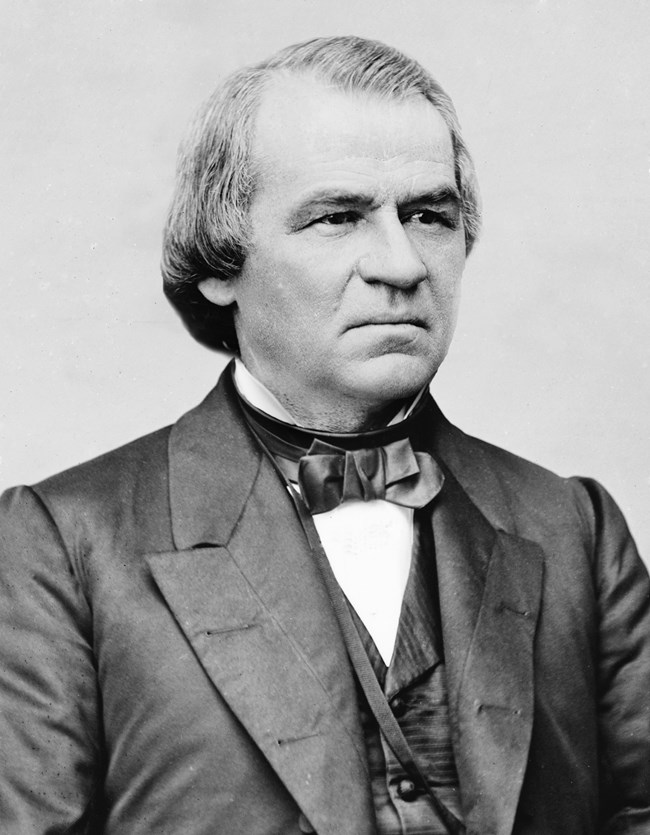Last updated: January 16, 2021
Article
Andrew Johnson's Inauguration

Library of Congress
On April 15, 1865, Andrew Johnson was sworn in as the 17th president of the United States. Unlike most inaugurations, Johnson’s was marked by sadness and tragedy. To many people, Andrew Johnson seemed like an unlikely person to become president. Born in poverty, Johnson was a tailor in Greeneville, Tennessee when he decided to seek public office in 1829. Over the next thirty years, he rose from mayor to congressman to senator. During the Civil War, he was the only southern senator to remain with the Union. His loyalty was rewarded when in March of 1862, President Lincoln named him military governor of Tennessee. As the election of 1864 approached, the newly formed National Union Party named Andrew Johnson as Lincoln’s vice presidential running mate. Lincoln and others in the party hoped Johnson’s nomination would encourage northern war democrats to vote for the ticket. After being sworn in as vice president in March of 1865, Johnston took up residence at the Kirkwood House, a hotel on Pennsylvania Avenue in downtown Washington, DC.

Library of Congress
While staying at the Kirkwood House, Johnson’s became one of the targets of a coordinated assassination attempt. In early 1865, Confederate sympathizer John Wilkes Booth organized a plot against President Lincoln. By early April, he had decided to kill not only the president, but also Vice President Johnson and Secretary of State William Seward. On the night of April 14, 1865, Booth ordered George Atzerodt to assassinate Andrew Johnson. While Atzerodt went to the Kirkwood House, he decided against killing Johnson. He instead fled the city but was captured, convicted, and hanged for his role in the Lincoln assassination plot. Shortly after Lincoln was shot, Johnson awoke to Leonard Farwell, a friend of Johnson's and former Governor of Wisconsin, knocking on his door. Farwell told him of the tragic events at Ford’s Theatre. Around dawn, Johnson walked the few blocks to the Petersen boarding house and saw the dying president. Before leaving to return to the Kirkwood House, he paid his respects to Lincoln’s wife Mary and son Robert. At 7:22 in the morning on April 15, Abraham Lincoln died. After his death, the cabinet signed a letter informing Andrew Johnson that he had now become president.
Upon learning of Lincoln’s death, Andrew Johnson sent word to the cabinet that he was prepared to take the oath of office. The cabinet then informed Chief Justice Salmon Chase of Lincoln’s death and asked him to go to the Kirkwood House. Around 11 in the morning, several members of the cabinet and a delegation of senators witnessed Chase swear in Andrew Johnson as president. Johnson then gave a brief speech where he told those present, “The duties of the office are mine; I will perform them—the consequences are with God. Gentlemen, I shall lean upon you; I feel I shall need your support. I am deeply impressed with the solemnity of the occasion and the responsibilities of the duties of the office I am assuming.”
